Eurasian lynx
Lynx lynx lynx

- FamilyCats (Felidae)
- Weight18 – 36 kg
- HabitatConiferous and mixed forests
Hairy reception
The Eurasian lynx’s hearing is so good that it can locate a mouse up to 50 m away. It has conspicuous, black tufts of hair on the tip of its ears that act like antennae, gathering and amplifying sound in the ear. It also has extraordinary eyesight: a Eurasian lynx’s eyes are six times more sensitive than humans, which allow it to see well at night.

Bobbed tail
Lynxes can easily be distinguished by their unusually short tail, a feature which scientists are still searching for an explanation. What is certain is that lynxes hunt primarily on the ground. Their method of hunting – stalking and sneaking – does not require a long tail to aid balance.
A Eurasian lynx can capture prey up to four times larger than itself.
Distribution


Hellabrunn participates in the European Studbook